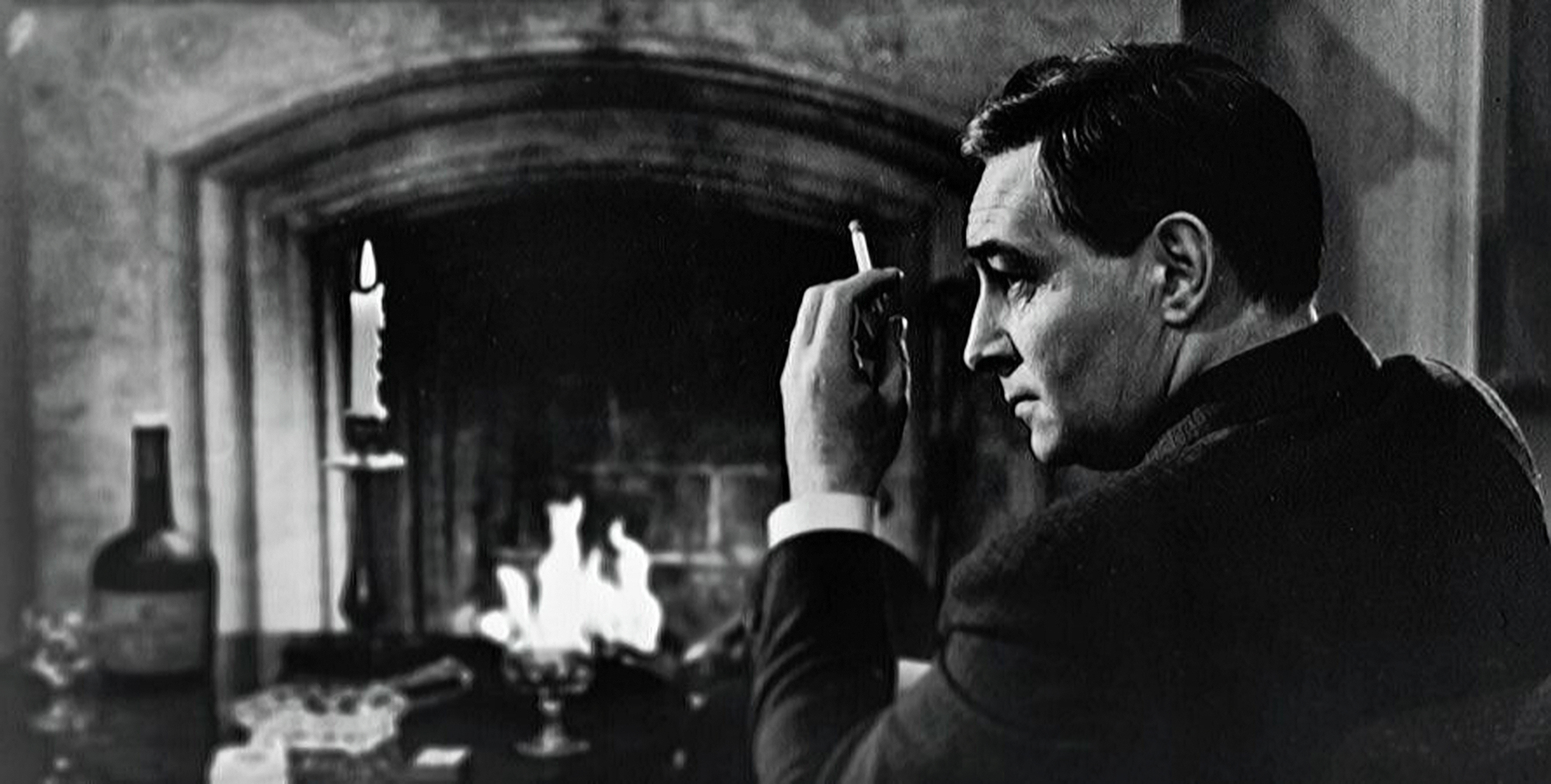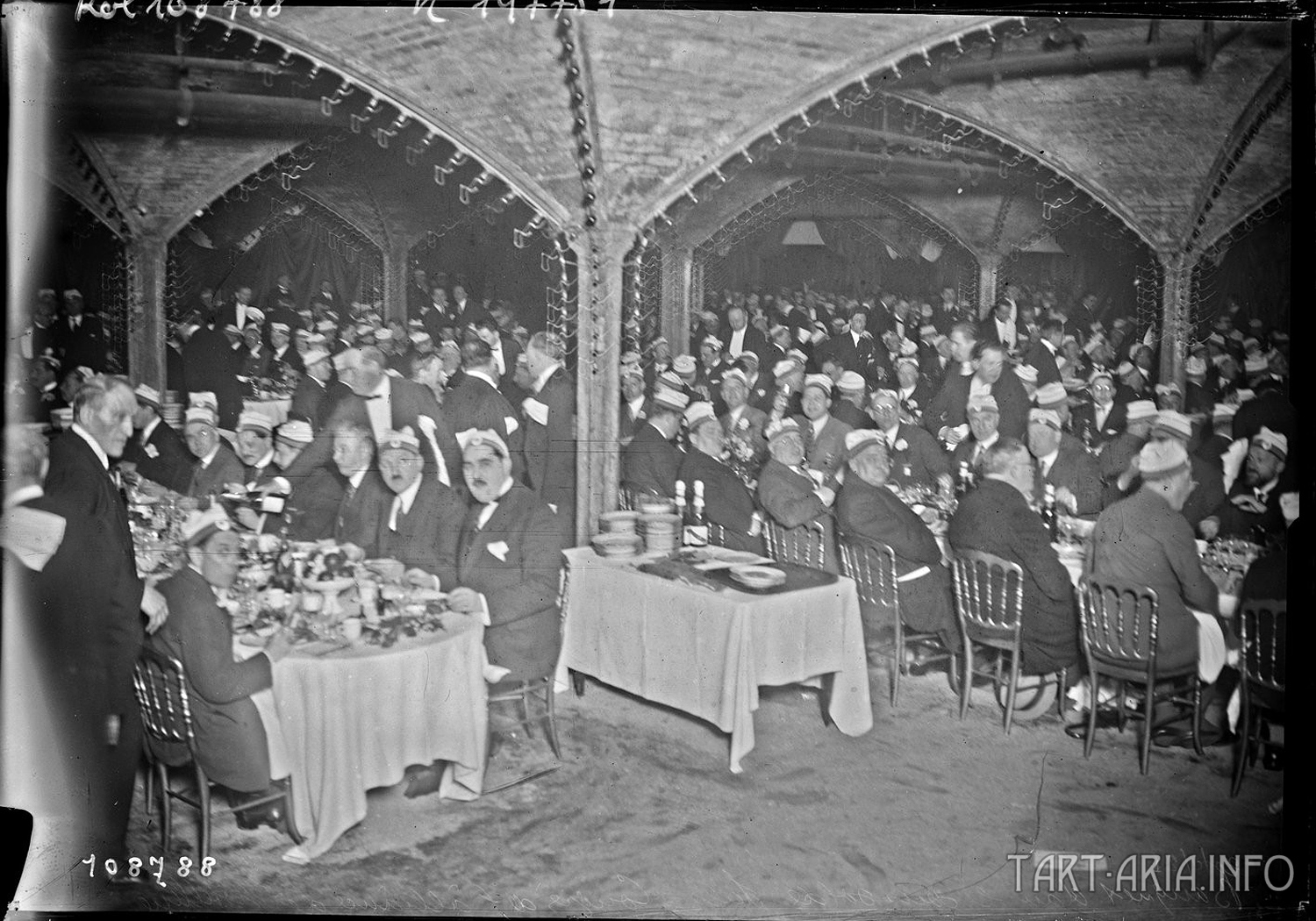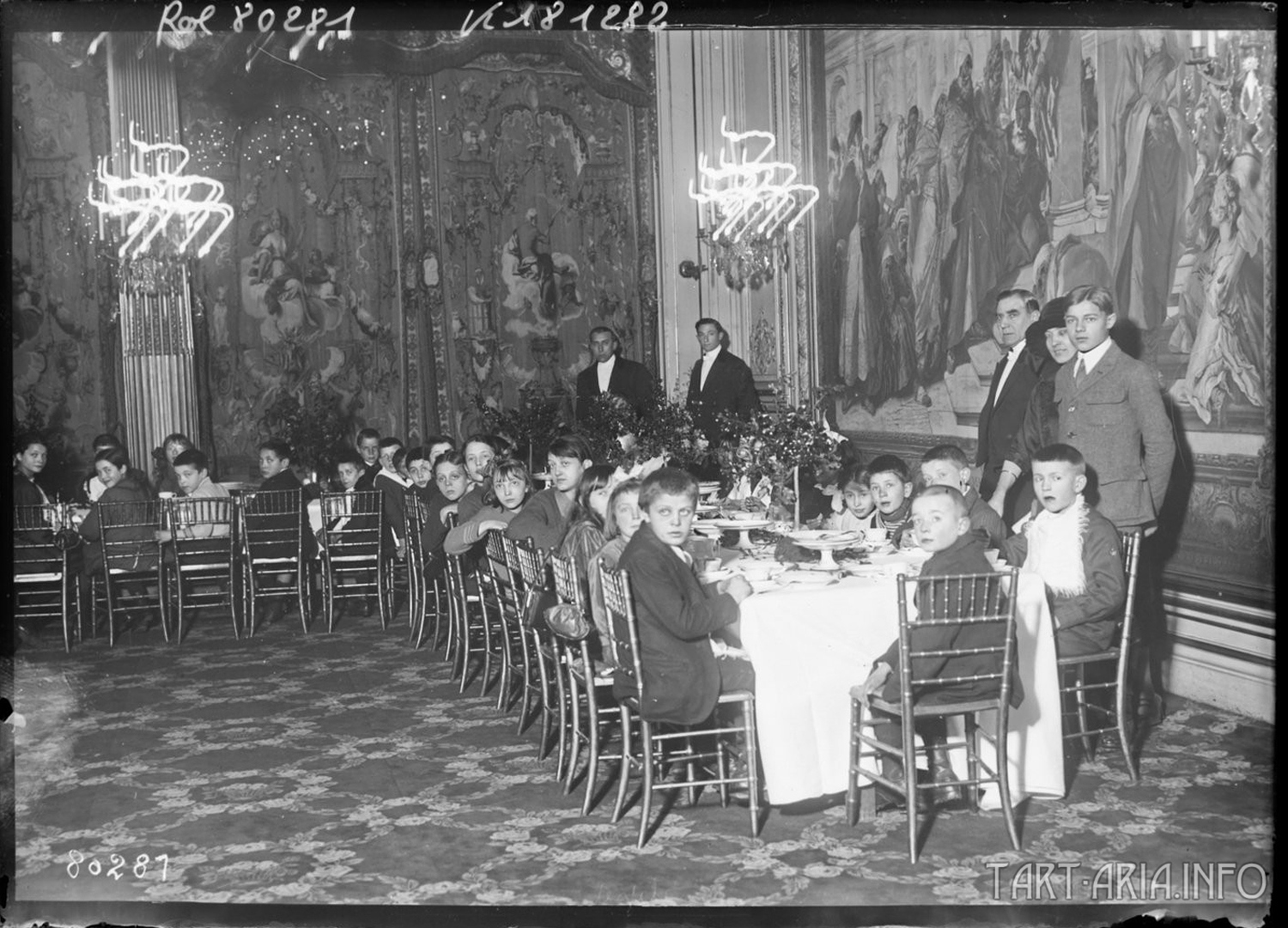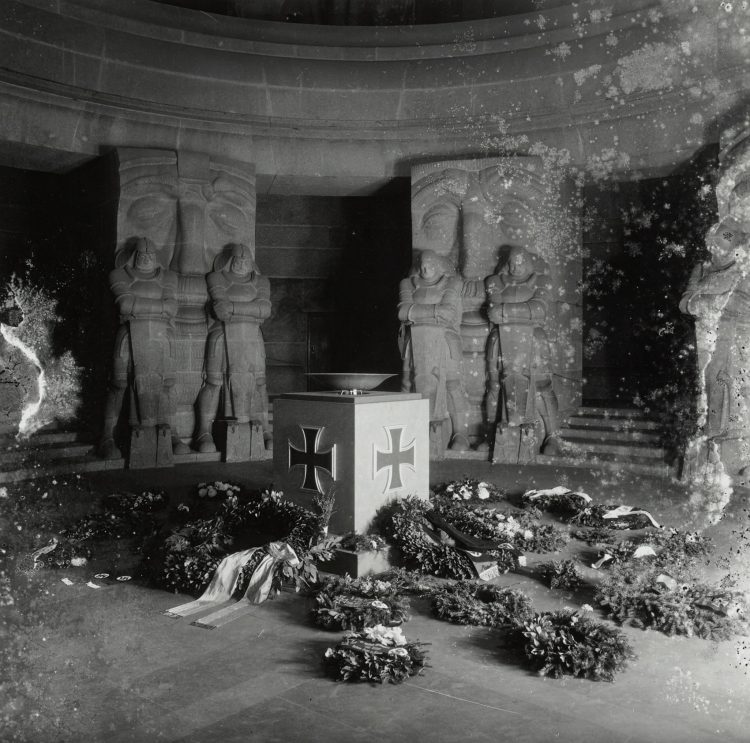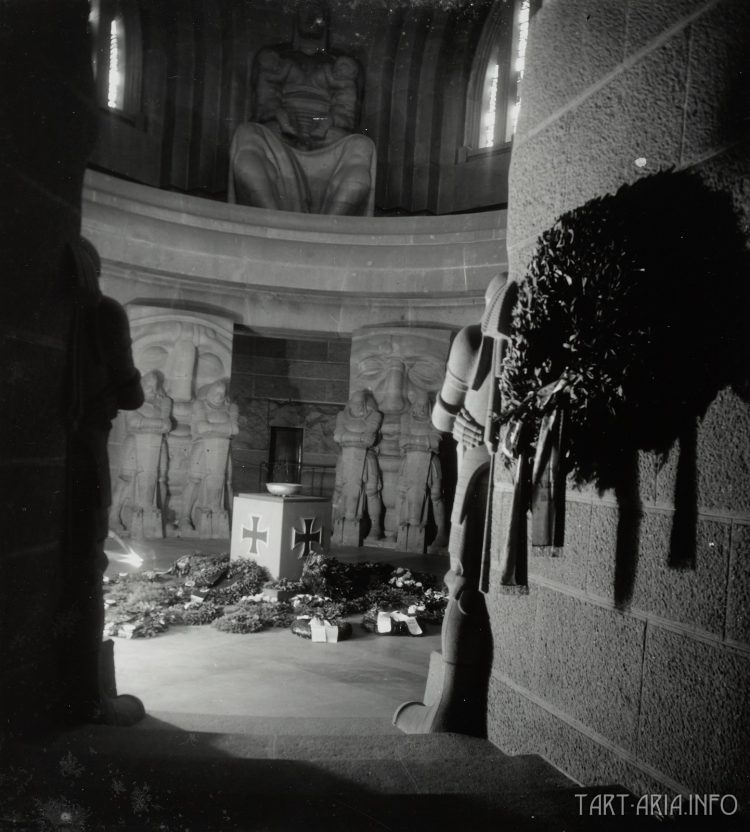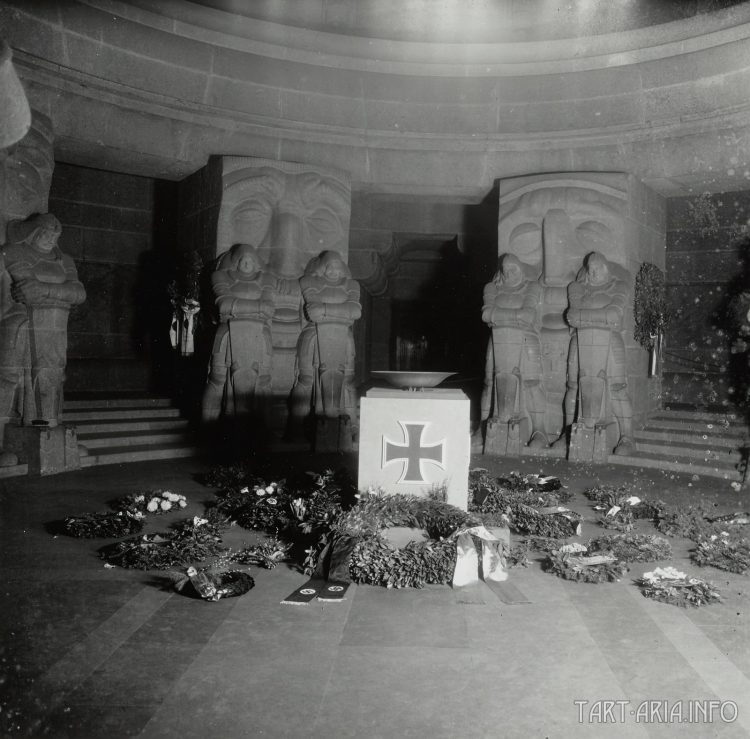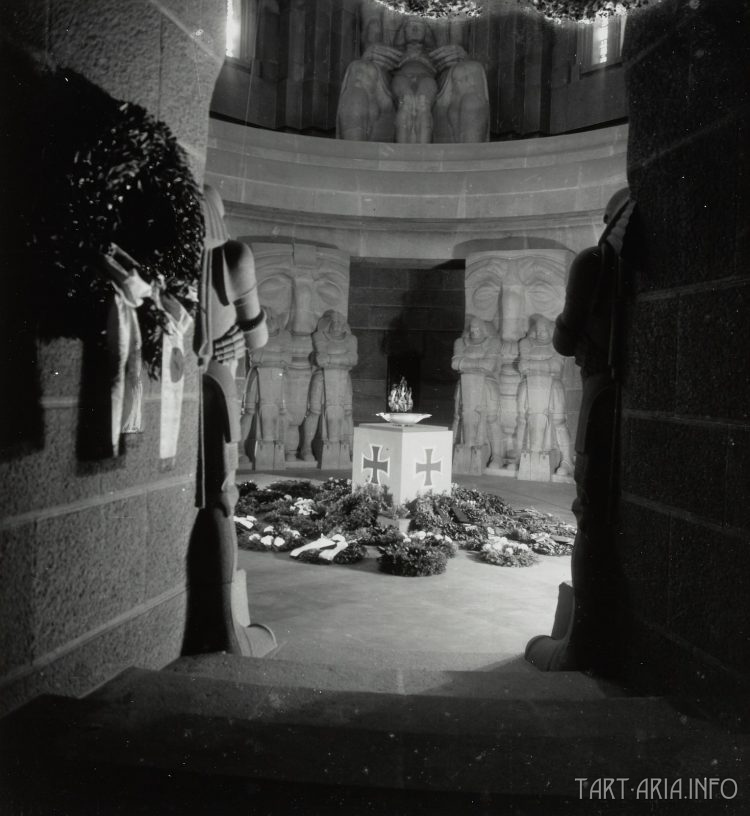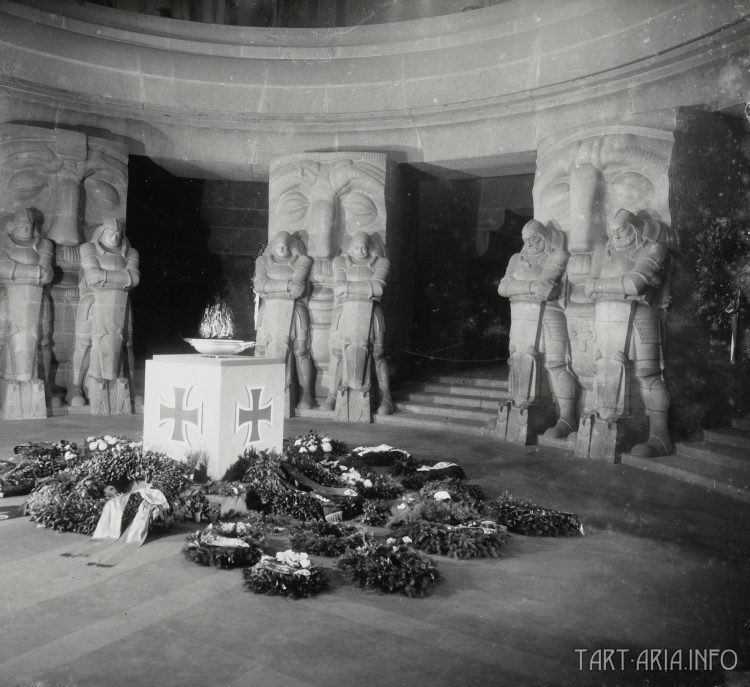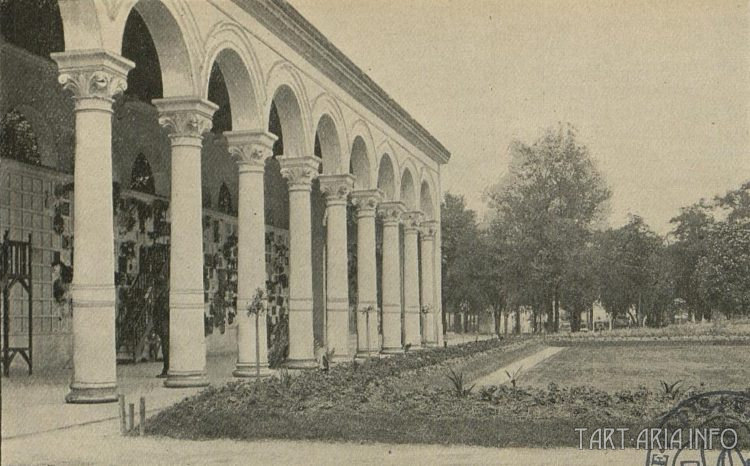Initially I wanted to title this article with the second option, but it turned out a bit gloomy. Moreover, I have already published articles on similar topics, so I did not want to repeat myself. Those who have read the last article (part 1 and part 2) have probably already guessed that we will talk about that very famous mortuary in the modern city of Volzhsky, on the opposite bank of Volgograd.
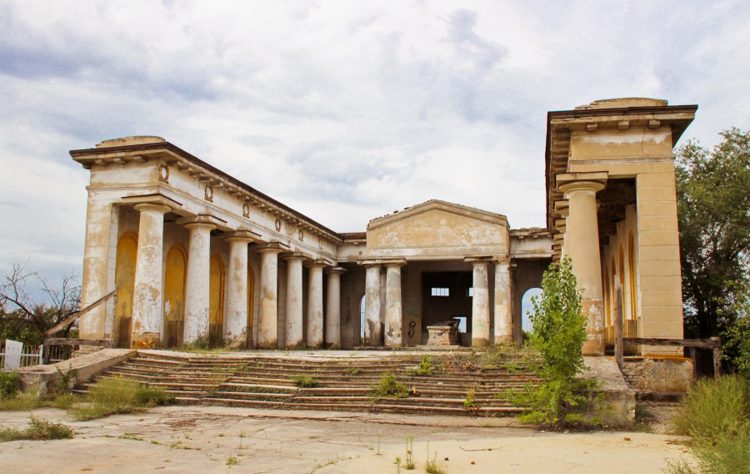
It is not entirely correct to consider this object out of the context of Volgograd’s history; therefore, links to the previous article will be given quite often. So,
A mortuary or pantheon is a ceremonial structure designed for conducting funeral rites. It is located on the territory of the city cemetery No. 1 in the city of Volzhsky. It is the only surviving object of this type, built in the times of USSR. According to one version, this П-shaped building was constructed in the early 1950s, simultaneously with the first phase of the city of Volzhsky. According to another version - at the end of 1958 by some architect from Moscow. The building was used to see off the deceased Volzhans, who made a significant contribution to the construction and development of the city. After the closure of the city cemetery No. 1, the mortuary was abandoned.
As I wrote earlier, the appearance of such an object in the USSR of the 50s of the 20th century looks unusual to say the least. The country that was struggling at that time to restore its national infrastructure, suddenly builds a facility like this one. And we don’t even consider the ideological side of question here. How could it be so?
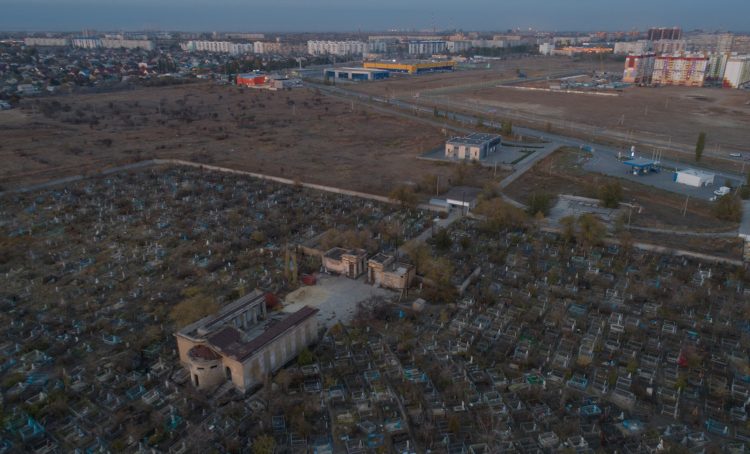
As you know, everyone is equal before God. There are no people who, after the appointed time, wouldn’t go «there», just as there are no people who ever managed to return from «there». And the recent war has confirmed this a thousand times. What was the point to single out people "who made a significant contribution to the construction and development of the city"? Can't we find out? (spoiler – you bet!)
A long time ago I published an article, which was largely unnoticed and caused a dispute among photography experts who were old enough to see USSR. Namely, there were some curious photos.
These photos look really strange, don’t they? Someone once convincingly argued that these are defects in photographic materials, carelessness of processors or movement of lens during exposure. Especially odd looks the Christmas tree, which, due to the strange glow at the edges, looks more like a decoration that was stuck in a staged photo. But the crown of creation was the following photo:

It is hard to explain how this case can be connected with a defect or carelessness of the photographer. Obviously, the cameras that took these photos managed to depict something that human eyes could not notice.

Indeed, how could it happen that a photo of HD quality (which itself is very surprising in relation to the end of the 19th century) was treated with reagents so carelessly? The secret of such spots in the photo becomes clear when you begin to look at the very chandelier above the tree from a close distance.

However, let's not duplicate that very article. Electricians will immediately see where I am going with this.
At one time, a relative who taught me photography warned that such oddities can be observed in old houses. Antique chandeliers (especially when being turned on) often gave a similar effect when cameras were pointed at them. Or could they illuminate something that human eyes would normally not perceive?
But what if there were similar devices in the mortuary that recorded something that is unknown to human eyes? You probably heard a story of father, son and a holy spirit. If the first two can be seen, the third is lost somewhere and is present only in prayers and proverbs. Could he be seen in the mortuary by the members of the processions who saw off the most worthy inhabitants of Stalingrad?

Why not? This is quite in the spirit of socialist-realism. There is an old superstition (that existed even in the USSR) to close all mirrors in a house where someone died. Maybe they covered those chandeliers for a similar reason? To prevent them from lighting up something? Apparently, this «something» could print unusual patterns on the photos. But what was it?
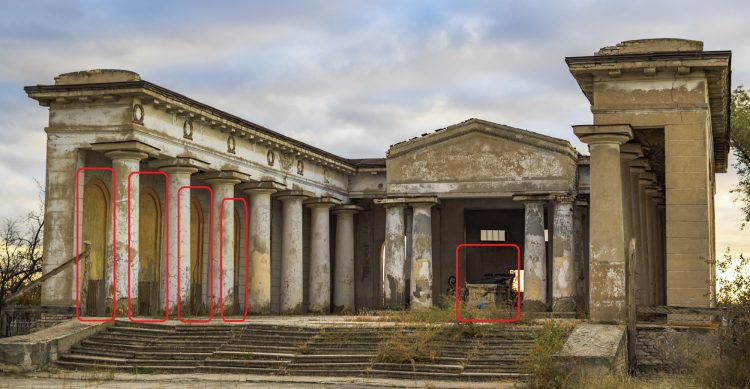
The single silicate brick, peeking through the peeling plaster in some places, convincingly proves to us the period when the structure was built. Without a doubt, this is the postwar Soviet Union. And at the same time there are some oddities. In the center of the composition, obviously, is a pedestal for the culprit of the procession (so to speak). Theoretically, all attention during the farewell should be directed to him. But at the same time, the niches on the sides seem suspicious. There are some kind of mural vases there, that obviously were used to light something up. The vases, however, have a very modern look.

It seems to me that the concrete floor was very clumsily poured on the already standing vases, and the vases themselves were clearly not made in the style of classicism, but according to the industrial design standards of the 20th century.
Why were these urns there? Wouldn’t they divert all the attention away from the procession and the main object of the ceremony when lit?

The plinth is clearly made of sand-lime brick, which stands on a red brick base. And at the same time, the lower visible layer of red brick is filled in half. This clearly proves that the slab of the pedestal was poured when the bottom of the pedestal was already standing. And the pedestal here is rather a foreign element than the original idea of the architect. What could initially be there?
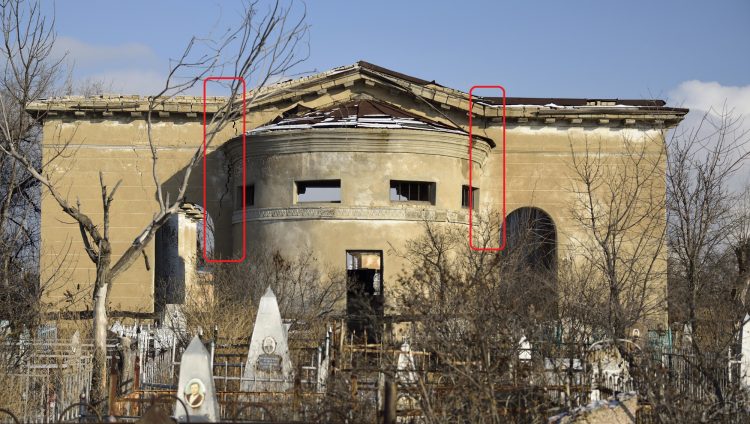
The cracks on the back side of the mortuary facade vividly show that the altar part here is autonomous and sags under its own weight differently from the rest of the building. It is also different in terms of the style. I have a strong feeling that this building was first built after the war, and at about the same time it was overhauled, adding a pedestal and an altar part. In fact, even Wikipedia confirms it. The first year of construction is 1950-52, the second is 1957-58.
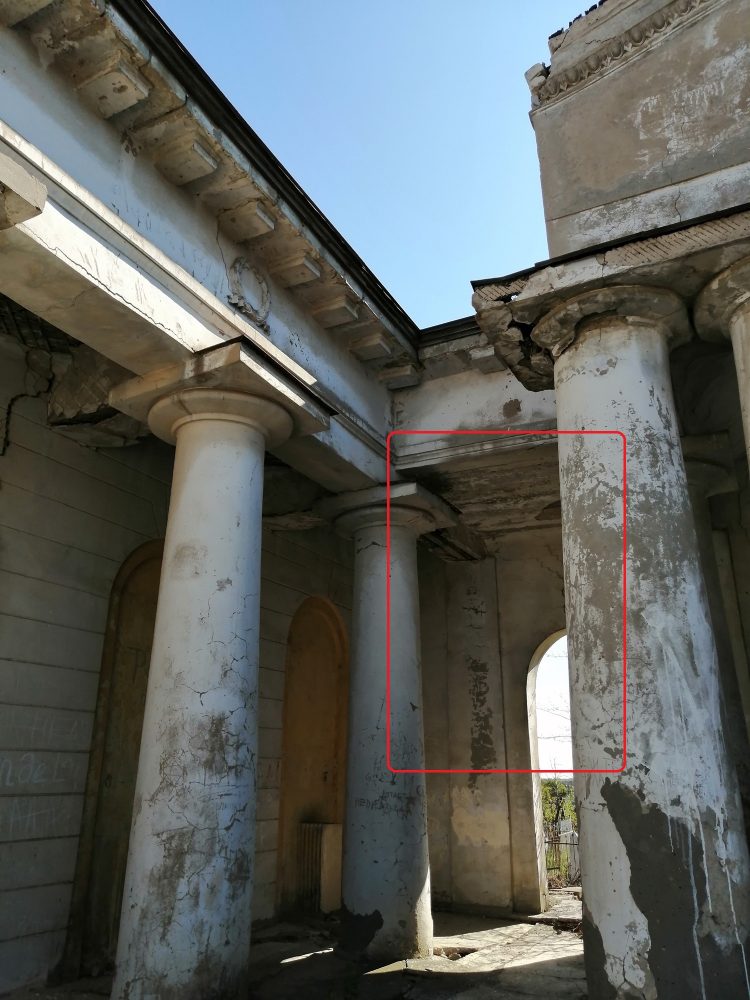
From the inside, it becomes even more noticeable. The altar part has a different quality of construction, and even its style is somewhat different from the sides.
What really was there?
Oddly enough, this object looks very mysterious in terms of its origin. If we were talking about an antique object, or even an object of the 19th century, everything would be quite ordinary. But absolutely nothing has been preserved in the archives about the construction of the mortuary in 1950s. This was confirmed in interviews by some important public officials. Even photographs of its construction have not survived. There were a lot of different rumors, but rumors are just rumors.
On the forums of local amateur historians, I managed to find information that the mortuary was built on the site of an older object with a similar purpose, which had been destroyed during the war. And after the war, the first burials began to appear in this place. To say that only important and famous people were buried in that place would not be entirely true - ordinary people were also buried there. But no one remembers exactly when the first burials appeared and when the mortuary appeared in that cemetery. Everything is covered with darkness.
Probably, there is no point in looking for any pieces of the original mortuary among existing photos. Now it is no longer possible to distinguish old parts from new ones. Moreover, the modern version of it started to deteriorate pretty soon after its construction, as modern builders couldn’t recreate the place with the same quality standards. But how could it look in the past? A glimpse of something similar can be found in antique pantheons.
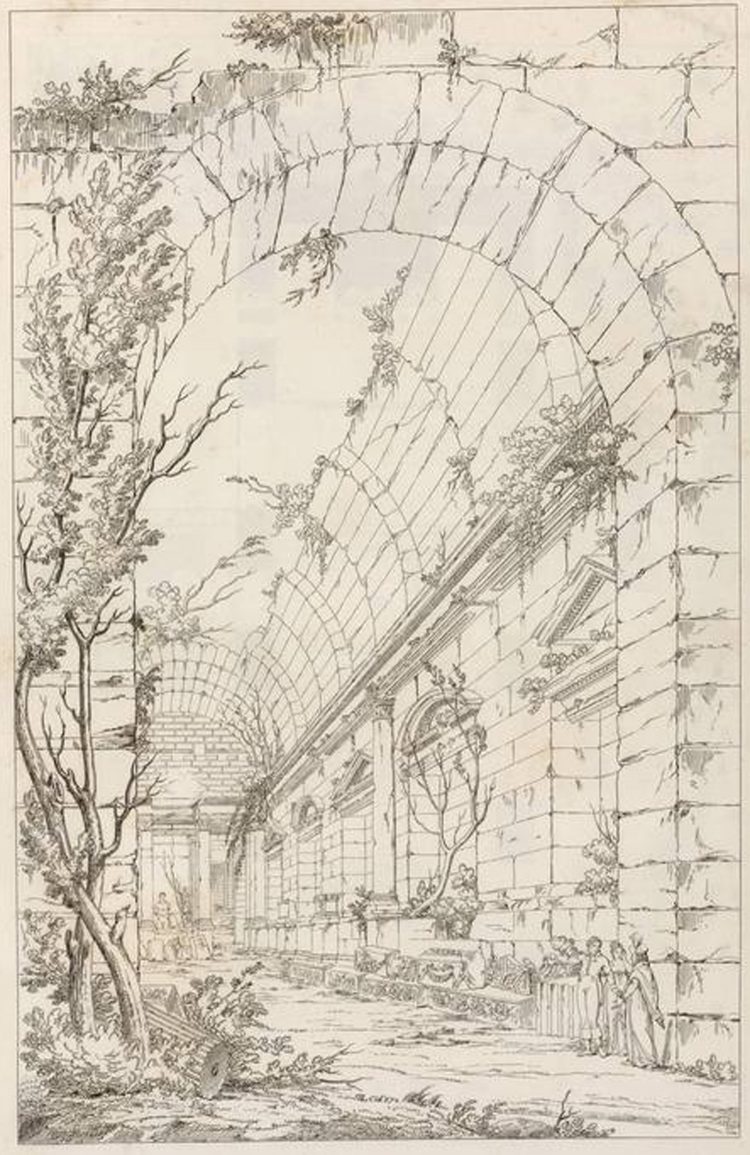
It’s unclear how much you can trust such engravings from Piranesi, but this is a view of a real ancient pantheon. Everything is very convincing - along the wall you can see the very niches we saw previously, though they are without vases. No wonder, these are ruins. Why were these niches made in the pantheons? But the most interesting thing was that the walls were connected with niches by a large arched ceiling, already destroyed in the drawing. Did modern architects try to recreate it in their mortuary?

Quite likely, but instead of an arched ceiling, they made a pedestal with an altar, and it was very clumsy and from materials that were available at hand. Even the ceiling was made of wood, which speaks of the unwillingness to make this structure durable and timeproof. While the niches and urns seem to be made just for decoration. Or were they bricked up and filled with concrete along with the bottom of the urns?
Urns, by the way, are a very interesting word. It should be noted here that during the transition of words from the ancient language to the modern language, the letters often changed places, thus changing the whole words and their meaning. One of the examples is a connection between the words «yard» and «core», which is «ядро» (yadro) in Russian. We can say that the letters could even be specifically interchanged for some reason. I wonder, can there be a similar connection between «urn» and «uranium»? If so, how could uranium be connected to these niches?
But let’s get back to antique pantheons.

It is Diana's pantheon from this engraving that assures us that the original design implied a ceiling arch above the walls. It seems that our mortuary was made in this image and likeness, but for some unknown reason, it was not completed. At the back of our mortuary, there should be two super-niches that weren't even planned to be built. Or were they torn down and turned into passages?
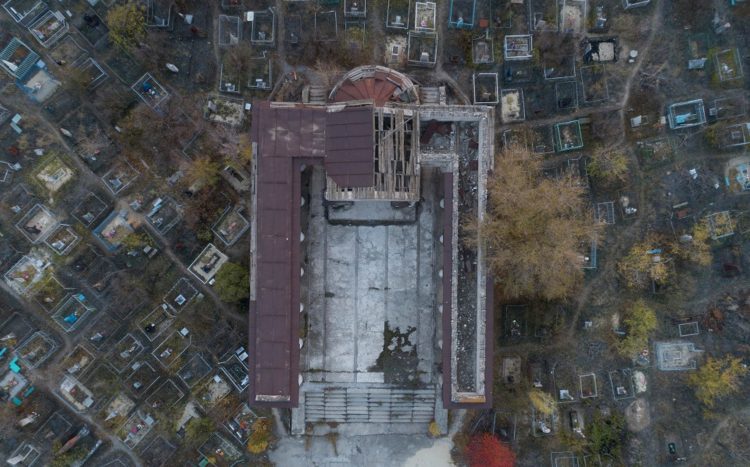
It seems that no one demolished anything, except that the entrances to the inter-wall space were improvised, and the altar part was made in a new non-canonical form. What for?
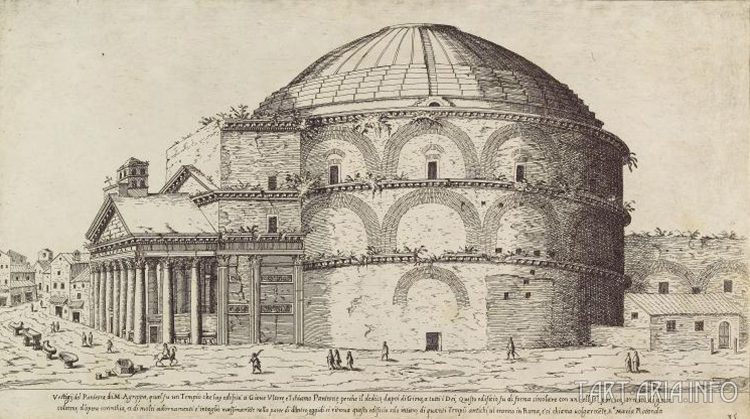
This one is also a pantheon, but Roman. It is based on a huge round building. It has no similarities with our pantheon, except that niches with urns were located there in the walls in a circle (there are many illustrations of its internal appearance on the network, including from Piranesi). Probably, these niches have always been the most important part of pantheons, and how to arrange them inside was not that significant. But what was their true purpose?
By the way, Wikipedia was clearly misinterpreting facts by saying that there were several similar mortuaries in the USSR, with only one surviving in Volzhsky. I don’t know what happened to other ancient buildings, but the one which was rebuilt in the USSR in the post-war period, was the only mortuary built there for ritual services (correct me if I am wrong). There were structures with a somewhat similar design, but they were used exclusively as museums, for example this one.
Moreover, even in Europe there is nothing of this kind. The only thing worth paying attention to (in terms of similarities in constructions’ purposes) is the monument to the Battle of Nations (aka Battle of Leipzig), located in Germany.

The Battle of Leipzig (also known as the Battle of the Nations) was the largest battle in the series of Napoleonic wars and in world history before the First World War, in which Emperor Napoleon I Bonaparte was defeated by the allied armies (author’s highlight) of Russia, Austria, Prussia and Sweden.
The battle took place on the territory of Saxony. The composition of both fighting sides included, among other things, the troops of various German states. On the first day of the battle on October 4 (16), 1813, Napoleon successfully attacked, but under pressure from the superior forces of the allies, he was forced to retreat to Leipzig on October 18. On October 19, Napoleon began his retreat to France with heavy losses. The battle ended the campaign of 1813, leaving France alone under Napoleon's rule, leading to the Allied invasion of France in 1814 and Napoleon's first abdication.
Many people died in that battle. Several tens of thousands of Russians were killed (according to official statistics). That very monument was built for the perpetuation of the fallen warriors.
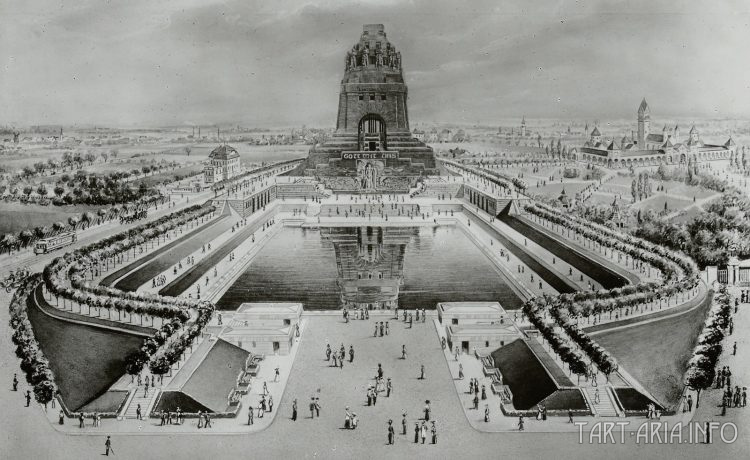

It is a known fact that Hitler loved this monument very much and repeatedly appointed various meetings inside of it. During the time of GDR (German Democratic Republic), they wanted to demolish the monument, but it was saved by the fact that it symbolized the military brotherhood of Russians and Germans, which fully corresponded to the political line of that time.
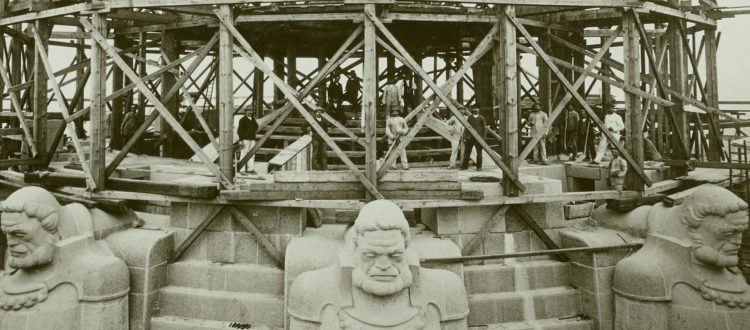
The monument was built in the 20th century, this fact is beyond doubt. The scale and technology are amazing. Were these objects really built with wooden scaffolding and by men in white jackets?
The laying of the foundation for the national memorial of the Battle of Nations took place on October 18, 1898. At the same time, Bruno Schmitz changed his original design in such a way that the base of the tower planned at the top turned into the main independent element of the structure, hiding a crypt as the central place of commemoration of the fallen. The grand opening took place on October 18, 1913, to the centenary of the Battle of the Nations. Funding was carried out mainly through a specially organized lottery and donations.
To make it clear right away, a crypt is a similar type of construction to mortuaries that we discussed earlier.
A crypt (from ancient Greek κρυptή – "a covered underground passage; cache") – in medieval Western European architecture one or more underground vaulted rooms located under the altar and choral parts of the temple and serving for burial and display for veneration of the relics of saints and martyrs. Another name for the crypt is "lower church".
In ancient Rome, any vaulted underground or semi-underground room was called crypt.
As a synonym for the word crypt, the Latin term sepulcrum (grave, tomb) can be used, which in pre-Christian times meant the place of ritual burning of the dead, later - Christian burials.
In Slavic languages, crypt was called by a more common word "склеп". The origin of this word is uncertain, but most suggestions fail to notice that this word looks very similar to the word "клепать" (ENG: to rivet). What could connect the funeral structure and plumbing work? Not the easiest question. But let's finish with our crypt from Leipzig first.
Since there are interesting details here that cannot be seen without scaling, we will return to these photos later. It is worth noting that in the left photo you can see traces of an inaccurate photographer. This is how the poorly washed fixer left marks on photographs. I also get a feeling that these photos miss a fictional character Max Otto von Stierlitz, which should be standing there in his uniform, silently mourning near the wreaths on the occasion of the anniversary of the Battle of the Nations. Yes, exactly so. Wreaths are there exactly for this occasion, to commemorate the dead.... including Russians.
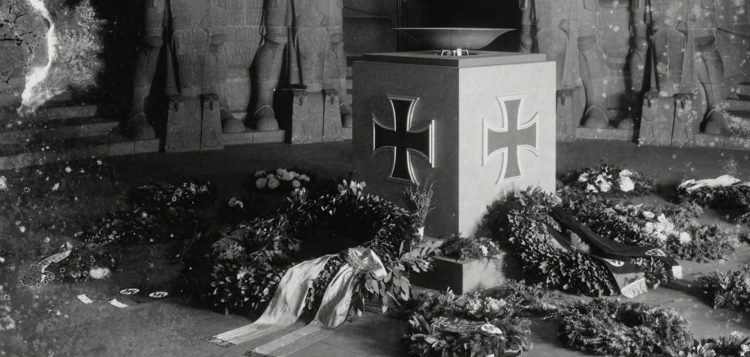
This is a zoomed version. Don't you find anything strange? The photo shows the very same spots that we looked into previously. But this is not the only odd thing here. Pay attention to the funeral wreaths, or rather to the symbols visible on some of them. This, let me remind you, is in honor of the dead Russians, Prussians, Austrians and Swedes. Now answer an important question – what state symbols did the territorial entity (that united these four nations at that time) have before the battle?
I suppose that the true picture is starting to unveil for many. If not, it's okay. As one saying goes, the time will come, and you will understand.....probably. After 1870, this huge territory was squeezed into the borders of modern Germany (still together with Prussia) and Austria-Hungary. While in other nearby countries they changed the whole history exactly the opposite. But in Germany, reverence for those killed in the Battle of the Nations continued at the state level. And the leader secretly wanted to restore the status quo. But, as time has shown, he made a strategic mistake. God is his judge.

Another question – where in this crypt are the very graves that, by definition, should be there? They are not in the crypt, nor behind the crypt. With such a large number of dead, the number of graves would have been such that it would would be impossible to hide them at all, and it definitely was not possible to do so the time of the construction. Where is the burial place? If they were cremated, the size of the columbarium would be impressive. But it’s not there. How so? Or could it be that Leipzig was just "appointed" as the site of that very battle by the clarifiers of history, thus shifting the emphasis between places and events of different scale? It was just the beginning of the 20th century after all – the time when the whole world was undergoing the reformatting (and Germany was not an exception).
If that’s the case, where was the real monument to those who perished in the Battle of Nations and where did that battle take place?
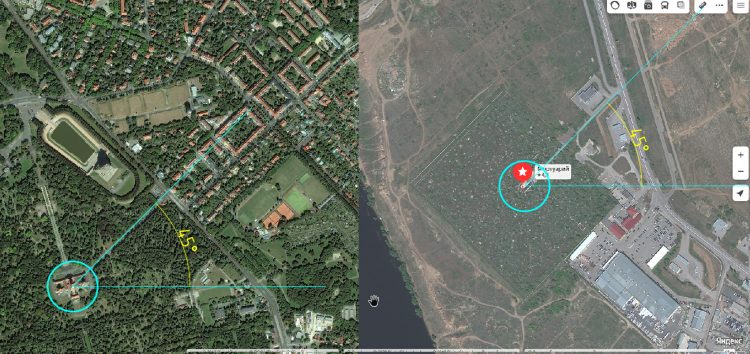
If you look at Leipzig (on the left in the picture) and take the crematorium building as a basis (circled in blue), then one of the alleys seems to be oddly moving away from it at the angle of 45 degrees (east-west), without getting into the crypt. But if you copy the resulting lines and transfer them to the plan of the mortuary in Volzhsky, then.... the direction of the alley coincides. Coincidence? I don’t think so. It looks like the real monument to the Battle of Nations in Leipzig has been converted into a crematorium. Or maybe it should be like that, in the form of a crematorium? But what about our newly built crypt?
But these are not the only oddities associated with the crypt.
What’s burning inside of it?
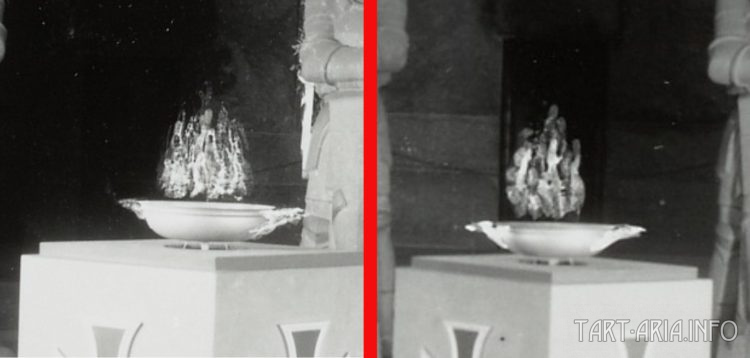
I am absolutely sure that this is not a gas burner or ordinary fire from a candle or other fossil fuel (look at the title image for comparison). You can think whatever you want, but the side edges of the plate glow, creating a halo, like the images of holy people on Russian religious icons. For comparison, look again at the weird Christmas tree photo shown earlier. The edges of that tree glow unnaturally, making it look like an element of decoration. What we have here is either a low-quality photoshop editing, or the first genuine case of the holy fire that appeared on the internet in the 21st century (in the crypt, where it belongs, and as far as the camera could capture it).
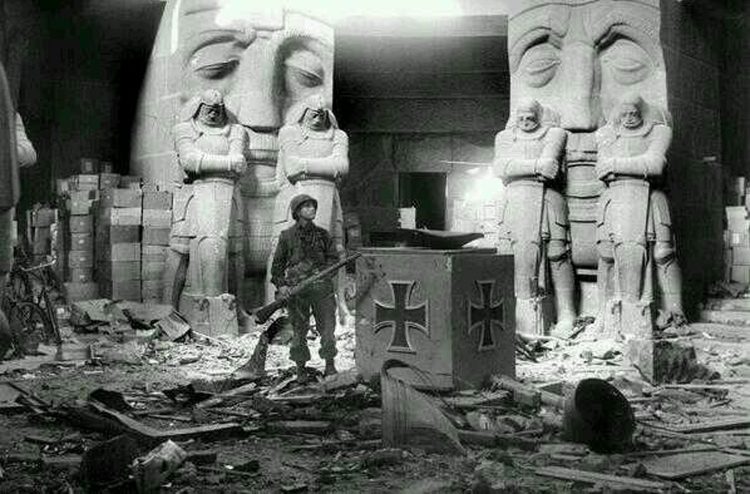
This photo is difficult to suspect of staging. Apparently, a representative of the Allied army poses in the crypt amid the chaos after the defense of the site. If our urn stands as if nothing had happened, then it was genuine and of impressive size. Compare what happened there after some incomplete 10 years.
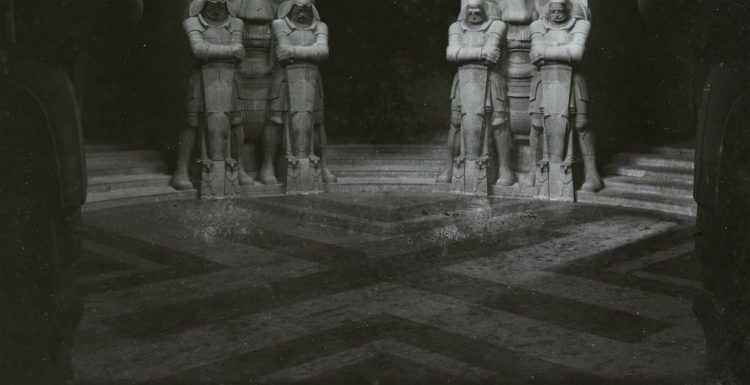
I suppose the question of Leipzig’s history can be addressed to the German local historians, while we will go back to the mortuary, keeping in mind our new findings. All this is surely wonderful, but according to the logic of things, the crypt and the mortuary should be a same place. But let’s look closer again at the words "крематорий" (ENG: crematorium) and "cклеп" and (ENG: crypt). In one case, something is riveted, and in the other, theoretically, a cream should be produced. One similar case has already been described here, where a very unique person was producing a now forgotten substance for obtaining energy from the air. Or maybe the very gas chambers used by Nazis were created not as a sophisticated method of murder, but an easy way of obtaining raw materials for his secret weapon, which they did not manage to create? Where is the logical connection between riveting and cream? It must be here. Let's search.
Cremation is officially believed to have come to Russia from the west. There seems to be no such tradition in Russian culture, at least in history since the 19th century, all the dead have been buried in cemeteries, even suiciders, albeit separately. As stated in the definition of the crypt, it was a place for the ritual burning of dead bodies, which was present exclusively in pre-Christian culture. Key words – ritual burning in pre-Christian culture. Well, let's suppose that in the west, it was considered, on the contrary, a more civilized method of burial. The body was burned, the resulting ashes were put into an urn (and again an urn), which was then placed in a columbarium. You can find a lot of photographs of old and new columbariums.
The purpose of the columbarium seems to be clear – a set of cells, each of which contains an urn with ashes. Only the word itself keeps bothering me. Columbarium, just like Columbus, known to all, has the same roots with the word "column". The same story with the word "colony". In colonies, affiliation was marked with a column. Where are the columns in the columbariums? Or is it just a relic word that has passed to the storage rooms of urns from another object?

I have always been amazed by various religious objects like those in the image. What kind of sinners were placed on them, I wonder? Or maybe these are the very columns of the columbarium? Now we will find out, but for now let’s return to the crematorium of the Pere Lachaise cemetery in Paris.
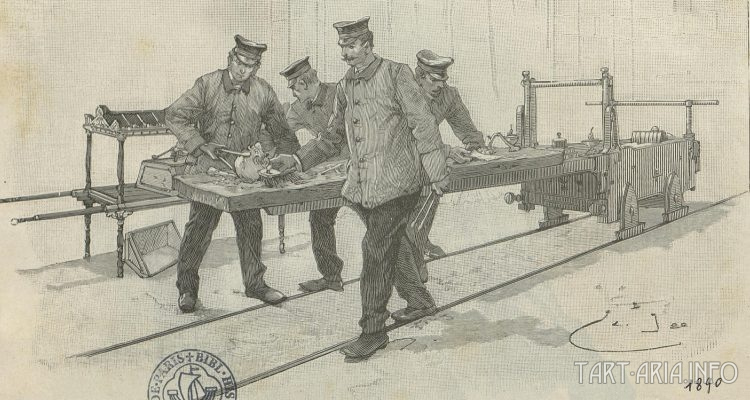
I apologize for the excessive naturalness, but here it seems that the crematorium employees are removing unburned ashes, and not into an urn. They just remove it and clear the table. But where is the urn? Or is there a secret in the oven itself?
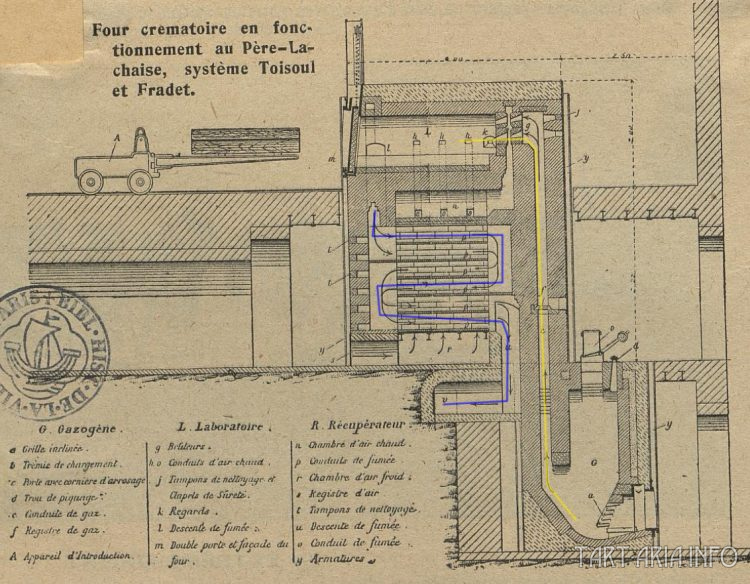
This is exactly what happens. Gas enters the firebox along the yellow line, which burns with the corpse. The spent smoke goes into a trap with horizontal sections, and after passing through it, it evaporates cleaned. Obviously, this is where the very dust settles, which is cleaned out through special holes. The question is - where did they get the gas from in the 19th century crematorium?
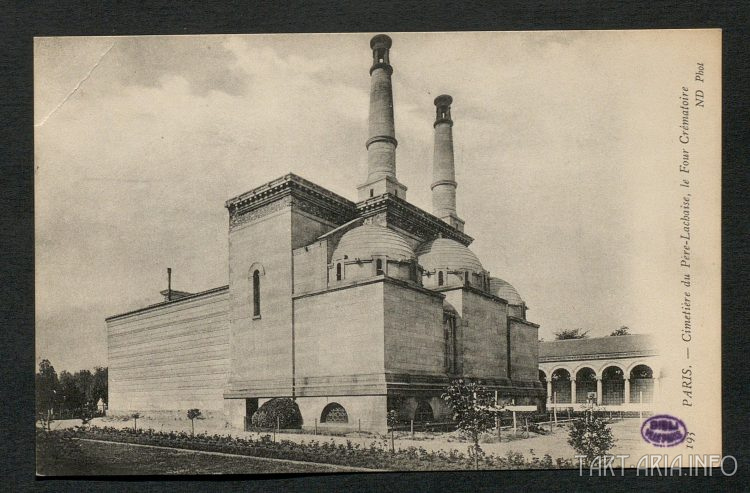
Although it is understandable. It is suffice to recall how the luminous gas appeared in general. Here, perhaps, is just a different type of the same gas production facility. The main principle is the same – air enters the high pipes from the outside and goes down into some devices for the dry distillation of organic fuel. Air comes out of these devices already mixed with gas. After cleaning, the gas can be transported further to consumers, moreover, via a fairly long distribution system. Naturally, those distillation devices used free energy from the air. I have some doubts that, in the case of the crematorium, there was no need to decompose (so to speak) the material into combustible gas and waste, so most likely the process went according to a simplified scheme. Only hot air was fed into the furnace, or, in the terminology of that time, a mixture of air with a special chemical element of the zero group of the periodic table of elements (heat-gen), or one of the subspecies of ether. At the beginning of the 20th century, the entire zero group of chemical elements was removed, and its existence in modern chemistry is presented as nonsense. This superheated air decomposed all organic compounds and blew them out into the very same smoke receiver.
But what then?
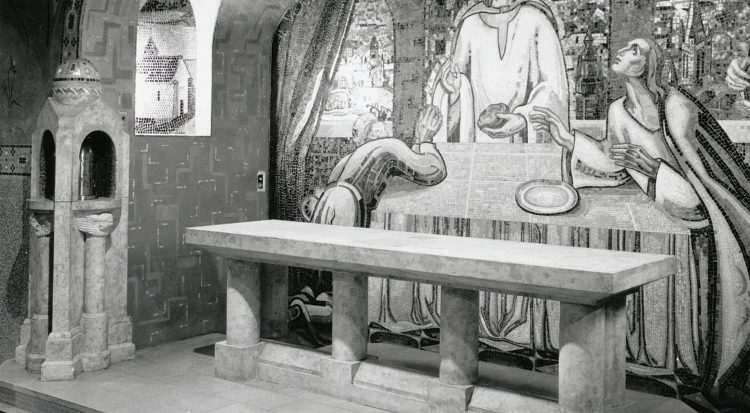
Usually our "uran-urns" were placed in devices like shown in the photo (on the left). One of its names is "рака" (ENG: an ark; a reliquary). Its fake version was often placed with a ceramic urn in various old cemeteries (both Orthodox and Catholic). The only difference is that in Orthodox churches the ark looked somewhat different – since the relics were placed in it entirely, it had completely different dimensions. And if you remove an upper part of this reliquary, what will you get?
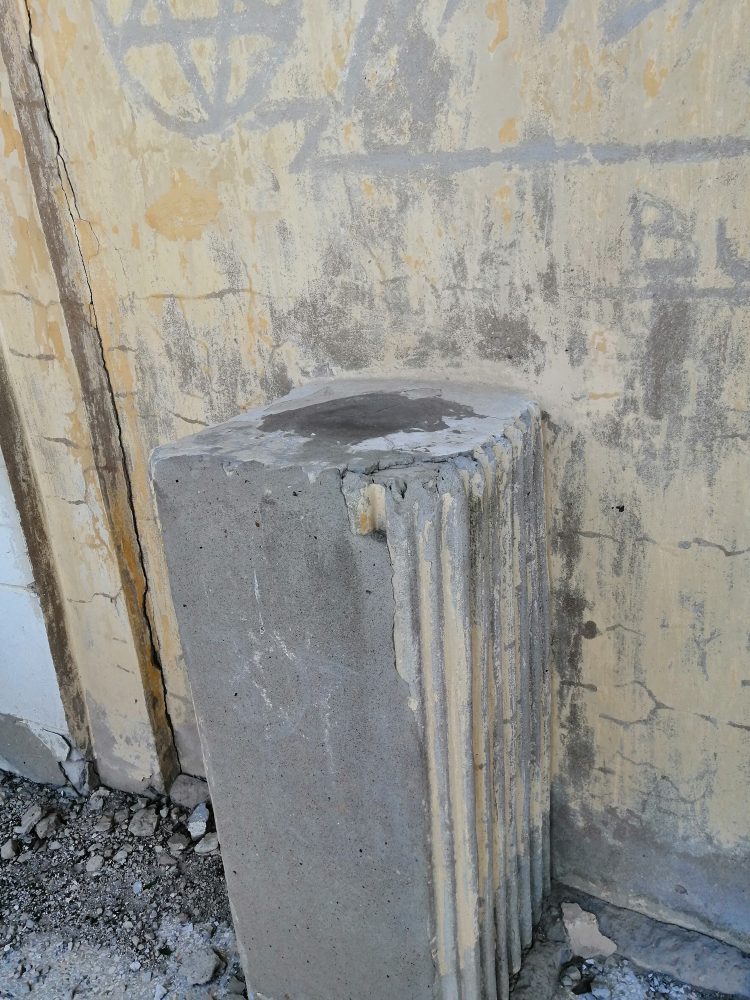
But this one is surely of a different style. Theoretically, such an urn stand should not lean against the wall. And if you remove the spike from the religious artifact (for sinners) I showed you previously, you will get the very same thing. But why was this spike needed? Let's remember my old article about riveting.

Let's imagine that the bolt hammered by the worker in this photo has the shape of that very spike (I guess it's not hard to imagine). If the shape of the striker of a jackhammer has a corresponding concave shape, then the hammer itself, after driving the bolts in, may even remain on top of it, standing stable despite the mass. And a set of such hammers would be stored in a special lockable place (the so-called crypt).
Let’s also imagine that inside of the hammer is the very product of the incineration of a corpse. If there was a need not to burn a corpse, but to put an embalmed mummy, then the container for these purposes would have large dimensions. In the Orthodox faith, you can see this quite often. The container for the mummy (or even its parts) is usually of an impressive size and is called "ark":
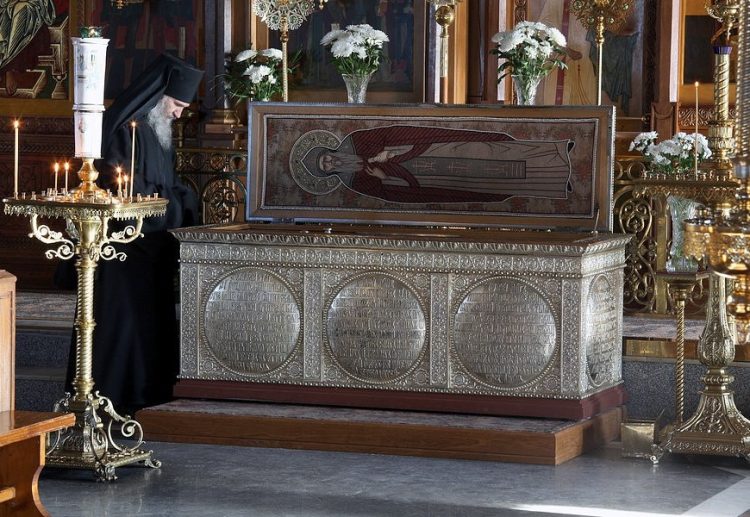
But if the corpse is burned, the resulting ash will easily fit into the volume of the same hammer. Doing so you get the same ark, but smaller. What’s curious is that Russian equivalent for the word "ark" is "рака" (raka), which is very similar to ракета (pronounced «raketa», or rocket in English). This "rocket" of course could not take off, but had its own unique properties. It is now preserved in Orthodox churches as a cargo cult. Haven't guessed yet?
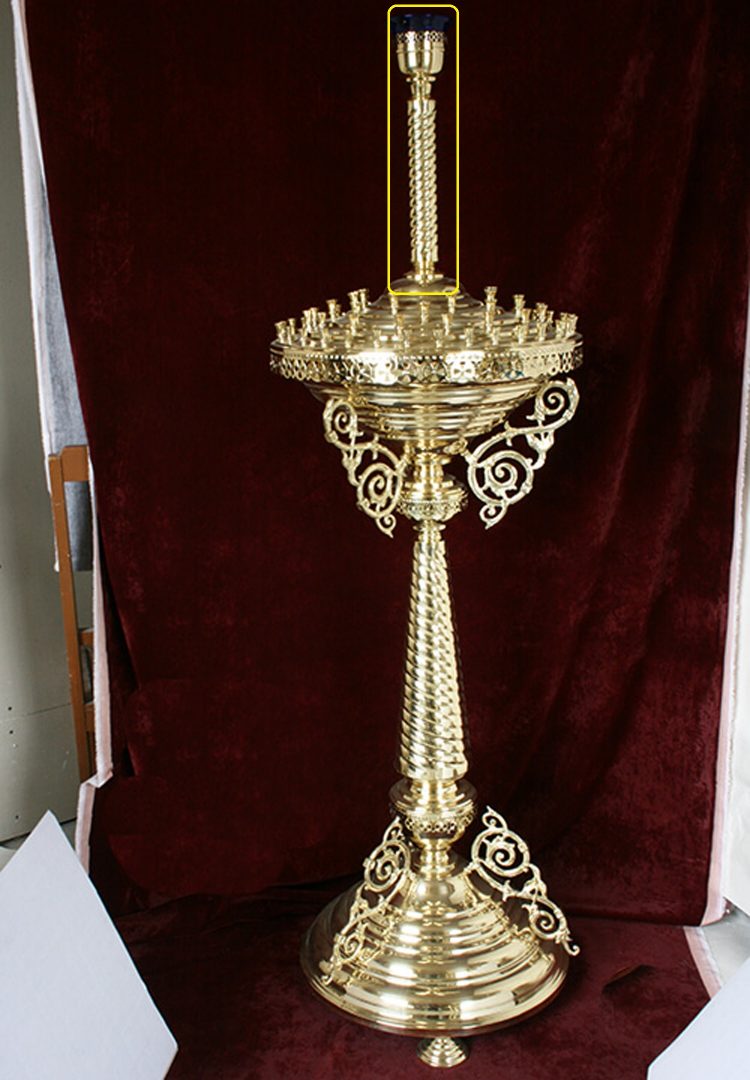
The main miracle of this rocket-looking device was the manifestation of that very holy spirit. And most likely, it was not just a manifestation, but rather a transferring of the optical image to the mirror, which stood behind. It was there that the desired effect was obtained, which in its turn could be perceived by ordinary human vision. Moreover, there is every reason to believe that a person not only saw the holy spirit, but could communicate with him through thoughts.
To demonstrate the burning of ether at school physics lessons, Fyodor Schwabe made equipment of this kind at the beginning of the 20th century. Under certain conditions, the oil in this "uranium" vessel should have burned with a very strange fire, if it could be called combustion at all.
For some reason, I remembered that in the distant Soviet childhood, on some holidays I received unusually large candies, made in the same shape. They were called rockets, though nobody understood why. But it definitely was not about Yuri Gagarin.
I wonder, is it true that a person's soul remains forever attached to his mortal body? In my distant childhood, old women used to say in all seriousness that if a deceased person was not carried out of building correctly, then his soul would forever remain there and suffer, without the opportunity to go to heaven. They also said that souls occasionally fly from heaven to visit us, and they rejoice with us if everything is fine with us, and vice versa grieve if everything is bad. But what if they did not lie, and under certain conditions it is possible to establish contact with the souls of the ancestors?
Nowadays, unfortunately, it is not possible. Instead of a mirror, a wooden board was placed behind the "rocket", with a ready-made and unchanging image of a holy man. Be content, so to speak, with what you have. There will be no other. Something resembles another episode of life from the USSR, when a toy TV with a ready-made drawing on the screen was sold. Why not? Good enough for children. And we all are like children in some way.
Well, let's assume that the ashes of a person could serve as raw materials for the "fuel" with which the device was powered. But how? Oh yes, we completely forgot about the cream. One must think that the cream is not only this ash. More precisely, the cream was made from ashes with the addition of something else. But what exactly was this something?
I recall one previous article, where on the plan of modern Volgograd, we made one unexpected discovery. Namely, in the area of handicraft/artisan settlements (slobodas) there have always been cemeteries. Moreover, we discovered handicraft settlements with cemeteries nearby even before Volgograd. It was at least in four cities. Where did this strange pattern come from? What could be the connection between handcrafting and cemeteries? Could they be making the very same cream for the unusual device. But from what? ... Let's go back to the mortuary.
In my last article, I examined one very interesting painting by Arnold Byocklin, titled "Tsaritsyn. Sacred Grove".
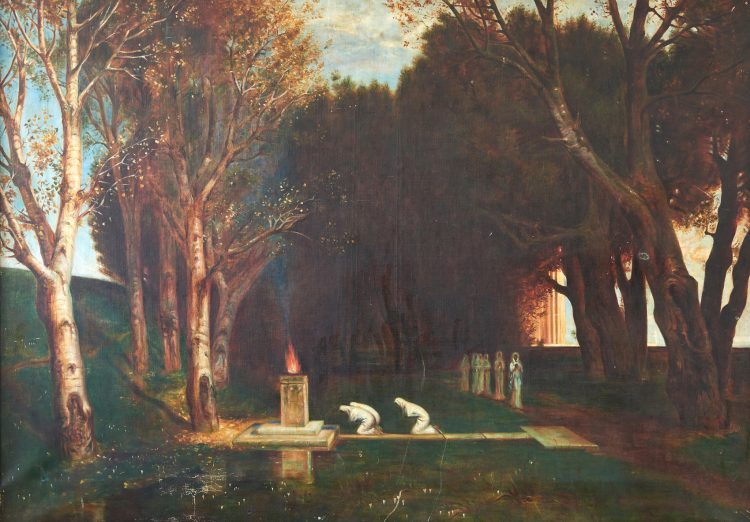
In the picture, we observe a strange scene, namely – a standing column, but without a rocket-shaped device, and with a burning fire. As already suggested in that article, the fire in the picture was most likely painted much later and not by the author himself, with the painting being republished (as it happened with many others). But let's imagine that the artist really saw this strange item on the column and that it was indeed in Tsaritsyno. The question is – why is this happening at the bottom of the canal and what kind of building is hiding there behind the trees in the background?
As we remember from the last article, the mortuary is connected precisely with the canals leading to the ancient city, on the ruins of which Stalingrad was built.

Is our mortuary really located on the former canal? How can this be verified? As it turned out, the answer lies very close. It is enough just to watch one video of local enthusiasts, and to work with one of the frames in the editor.

It is clearly seen that the graves run in some special rows, the axes of which (yellow lines) tangentially bypass a certain round-shaped area in the center. Let's rewind again and look at the Roman pantheon. What is this area and why is the cemetery laid out similarly to the British flag?
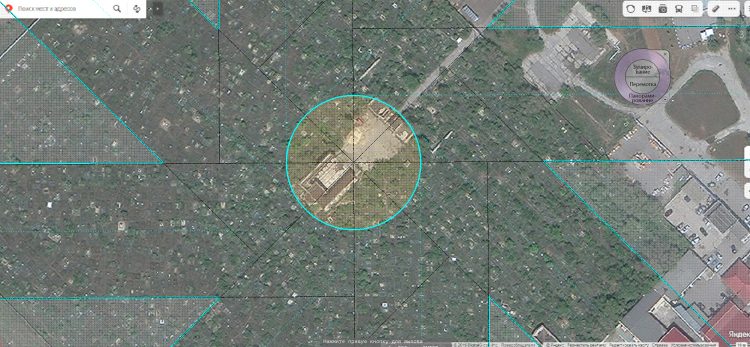
But if you clarify the rows of graves according to the satellite, everything looks much grander. The meaning of these rows is quite simple. Obviously, earlier on the site of the mortuary there was an island on which stood something. And the channels approached this something in the image and likeness of the spiral symbols discussed earlier. After an unknown war or an unknown cataclysm, the elements leveled these canals, letting water flow into the bed of the modern Akhtuba River. Eventually it all transformed into an ordered set of grave rows, which copied directions of former water canals.
One small objection - people began to bury there only right after the war. Why? Were they not allowed or people who inhabited a handicraft settlement there just disappeared after the war? Or do you doubt that there was a handcraft settlement there? It seems like people carried dead bodies there because of an old memory, in order to make fuel for the rocket-shaped devices, but due to the lack of appropriate services, they buried bodies in the immediate vicinity. They couldn’t just carry those dead bodies back, could they? And then this process became a tradition.
But what actually used to be at the location of the mortuary?
Surprisingly, with all the variety of aerial footage of Stalingrad from the Luftwaffe, this place somehow did not get into the review at all. This place may have been filmed, but hasn’t been published due to unpopularity of the location. Nevertheless, I managed to find something.

Looks like at some point the operator pointed the lens through the Stalingrad tractor plant to the east. I wonder if he had a slightest thought at that moment that he was filming something very interesting? Unlikely. And what do we see when we zoom in?
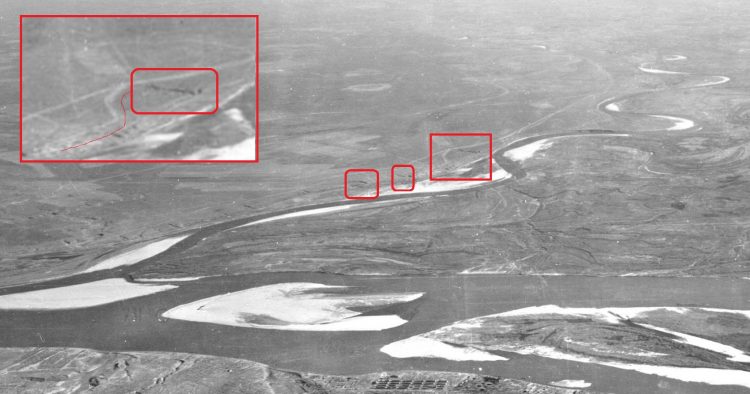
Well..... There was a whole linear object of considerable size, which even went around country roads. And similar linear objects, but smaller in size, existed along the entire bank of the Akhtuba, as if someone had drawn them along a ruler. One of them even had a semicircular shape (the leftmost circled), like a half of the Colosseum. Can this be a mistake?
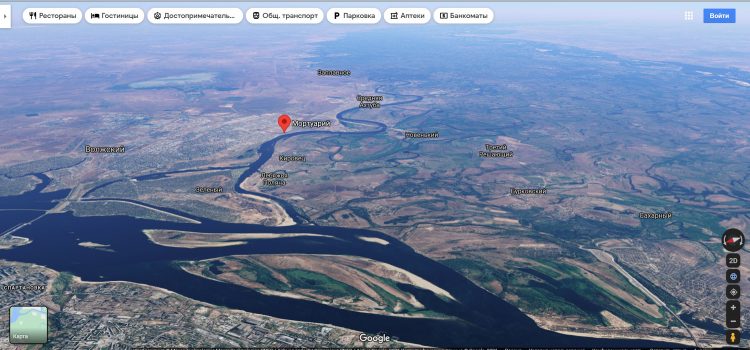
The technical capabilities of the 21st century prove to us that this is not a mistake at all. Unless the Volga-Akhtuba canal, dug after the launch of the hydroelectric power station, changed the coastline of Akhtuba in the area of the former Bezrodnoye village. What kind of object was there?
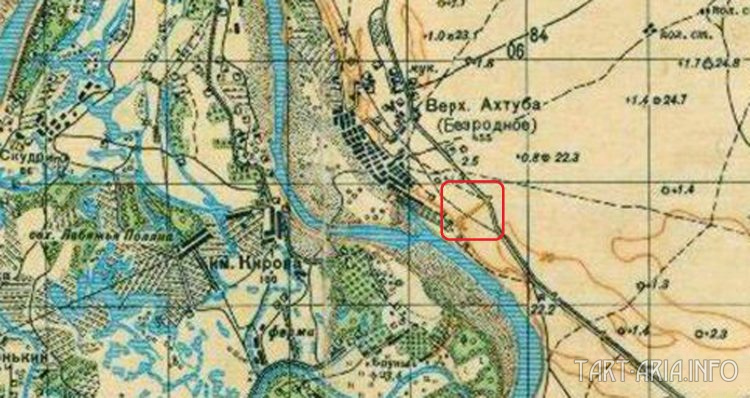
Our object is clearly indicated on the map of the General Staff of the Red Army, though without any identification marks, which is quite alarming. So in which channel did Arnold Byocklin see the plot of his painting?
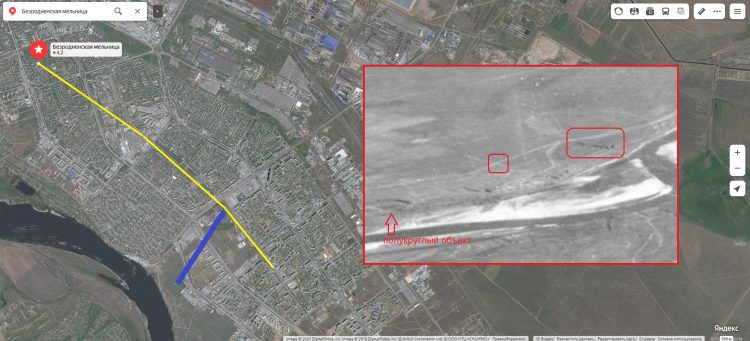
If we take as a basis one of the very few surviving attractions of the old Volzhsky - the Bezrodnoe mill, and hypothetically draw a dirt road from it, which goes to the top of our object and is visible in the photo from the Luftwaffe, then we can estimate the length of this object. Considerable length.
And what is at the end of our object on the map now?
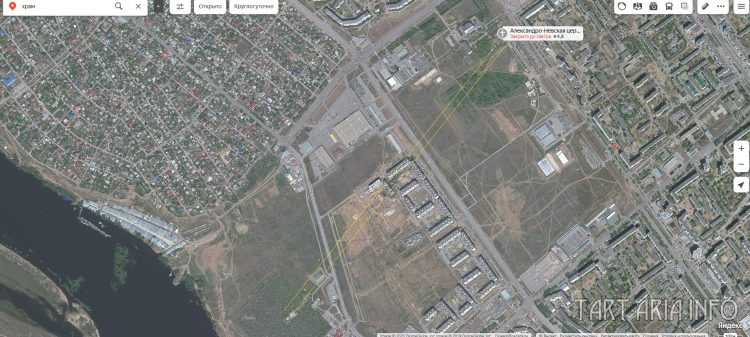
If the channel went to the mortuary with an offset, as we reconstructed earlier on the "British flag", then the diagnosis is completely clear. Almost like in Leipzig.
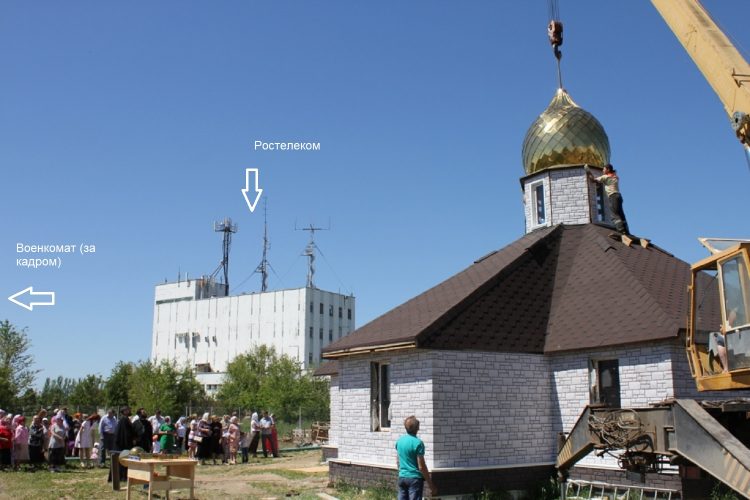
If you look at this new temple from east to west, you will see this picture. A «Rostelecom» building and a military recruiting station, standing nearby, indicate that we are on the right track. During the construction of Volzhsky, our object was cut on the surface, but its underground part is still intact and interconnected. At one end of the object, a fake mortuary was built, and at the other end, an art gallery was put up (well, almost).
What kind of object was there?
During the study of the military graves of the city of Volzhsky, which are in the public domain, some interesting facts were found. It turns out that there are several mass graves in the city, in which the victims of the Civil War were buried. The victims of the Second World War were buried then in the same places. The most famous grave is located almost in the center of the old Volzhsky, on the bank of the Akhtuba.

Let’s assume that during the World War II there was a hospital nearby (which is actually not a secret). All those who died from wounds were buried here. But why does this place keep those who died in the Civil War, if this place has no direct relation to it? Anyway, only god knows the truth. In that war brother fought against brother and son against father, so anything could happen there. Then the next question is - why was this location chosen for the mortuary where, as they say officially, the persons who distinguished themselves in the history of the city were buried? Could locals keep bringing dead bodies there because they had memories of an old tradition to bury or cremate bodies there? Anyway, after the war the object lost its status and could even disappear due to damage. But what was there?

There was something special, genuine, and with "uranium rockets" of large size. It was a gallery of heroes. But those heroes belonged to a forgotten war. Try to guess which one. And before our modern oblivion, they honored the fallen on a significant scale. For obvious reasons, unknown soldiers could not be there by definition. The "rockets" eloquently showed everyone, along the entire length of the structure.
The tradition of making alleys of heroes is a thing of the past. But no one knows how the real alleys of heroes looked like even quite recently, less than two centuries ago. At some point of time they were completely forgotten. All memorials that were built subsequently were rather decorative.
Our real alley of heroes appeared approximately at the beginning of the 19th century, almost at the time when the very Battle of Nations took place. Obviously, this location was the main shrine of Katharinenstadt. During the war of 1870, this place was destroyed, and then it was no longer rebuilt until the times of the USSR. Under some unknown circumstances, the object began to be restored in the 30s of the 20th century, apparently with the aim of creating places of unusual burials of famous people, but in the traditions of the past. So that the younger generation could come and talk at especially solemn moments. To say that it was sensational for the whole world is to say nothing. But on the other hand, it was very strong in the spirit of that perky socialism, when everyone went against traditions and foundations, and were not afraid of difficulties.
In 1950, the first phase of this unique project was launched. As you already understood, this was our mortuary, which was not at all like that. It had a different structure, more like the Roman pantheon, and had at least two floors in depth. The entrance was placed where the pedestal for the coffin stands now. The crematorium and columbarium were located there. And as you might expect, after 1953 this mortuary was demolished. Then, on the wreckage of the old construction, they built a new one (the one we see today). At first, I thought that it was rebuilt with the removal of some details, but unfortunately, this is a completely modern object, exclusively for fake purposes.
Imagine what it could have looked like now, if that plan had somehow been carried out. Unlucky children could have been receiving instructions from their departed parents. No unsolved murders. The whole history would have been known without white spots. All the tribes that have been at enmity all their lives (and still are) would have suddenly realized that they can’t live like this any longer. And everything would have returned to the state that was lost around 200 (or even less) years ago. But unfortunately, it all turned out differently, and probably will never go back. Why should it?
P.S. Thank you for the photos of the mortuary, I am very grateful. And remember that the more we reflect on such articles, the faster and more persistently they want to vaccinate us. So don't clutter up the comments.








